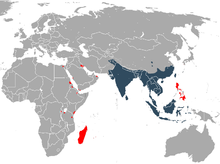Asian house shrew
| Asian House Shrew | |
|---|---|

| |
| Scientific classification | |
| Domain: | Eukaryota |
| Kingdom: | Animalia |
| Phylum: | Chordata |
| Class: | Mammalia |
| Order: | Eulipotyphla |
| Family: | Soricidae |
| Genus: | Suncus |
| Species: | S. murinus[1]
|
| Binomial name | |
| Suncus murinus[1] | |

| |
| Asian house shrew range (blue — native, red — introduced) | |
| Synonyms | |
|
Sorex murinus Linnaeus, 1766 | |
The Asian house shrew (Suncus murinus) is a type of shrew. It is native to South and Southeast Asia. It is the largest type of shrew. It is a least concern species. It has been introduced in several West Asian and East African countries.[3] It is an invasive species.[4]
Description[change | change source]
The Asian house shrew is 100 mm and 150 mm long. An adult female weighs between 23.5 g and 82.0 g. An adult male weighs from 33.2 g to 147.3 g.[5] It has short, dense fur. It is mid-grey to brownish-grey color.[6]
Distribution and Habitat[change | change source]
The Asian house shrew is native to South and Southeast Asia. It was introduced to eastern Africa, Arabia, Madagascar, the Philippines and other islands in the Indian and Pacific Oceans.[3]
It is found in forests, agricultural lands, and in places with lots of human activity. It is also found in many houses and businesses. It is mainly a terrestrial animal.[5]
Feeding[change | change source]
It is mainly an insectivore. It eats insects, mammals, plants and human food.[5]
Behaviour[change | change source]
It very adaptable species. They are nocturnal. They are thought to mainly live by themselves.[5]
Reproduction[change | change source]
They breed throughout the year. It gives birth to one to eight young ones. The gestation period is one month. It starts breeding when it is around one year old.[7]
Relationships with humans[change | change source]
It helps to control the population of many pests. It is an invasive species. They compete with many types of plants and animals. It is also a pest. It can damage food and other materials found in homes and businesses.[5]
References[change | change source]
- ↑ Hutterer, Rainer (2005). Don E. Wilson; DeeAnn M. Reeder (eds.). Mammal Species of the World (3rd ed.). Johns Hopkins University Press. pp. 260–261. ISBN 978-0-8018-8221-0.
- ↑ Hutterer, R.; Molur, S. & Heaney, L. (2016). "Suncus murinus". IUCN Red List of Threatened Species. 2016: e.T41440A22287830.
- ↑ 3.0 3.1 Hutterer, R. (2016-02-01). "IUCN Red List of Threatened Species: Suncus murinus". IUCN Red List of Threatened Species. Retrieved 2020-09-22.
- ↑ "GISD". www.iucngisd.org. Retrieved 2020-09-22.
- ↑ 5.0 5.1 5.2 5.3 5.4 Lench, Jessica. "Suncus murinus (Asian house shrew)". Animal Diversity Web. Retrieved 2020-09-22.
- ↑ Louch, Charles D.; Ghosh, Ajoy Kumar; Pal, Bikash C. (1966). "Seasonal Changes in Weight and Reproductive Activity of Suncus murinus in West Bengal, India". Journal of Mammalogy. 47 (1): 73–78. doi:10.2307/1378070. JSTOR 1378070. PMID 5905563.
- ↑ Temple, J. L. (2004-01-01). "The Musk Shrew (Suncus murinus): A Model Species for Studies of Nutritional Regulation of Reproduction". ILAR Journal. 45 (1): 25–34. doi:10.1093/ilar.45.1.25. ISSN 1084-2020. PMID 14752205.

